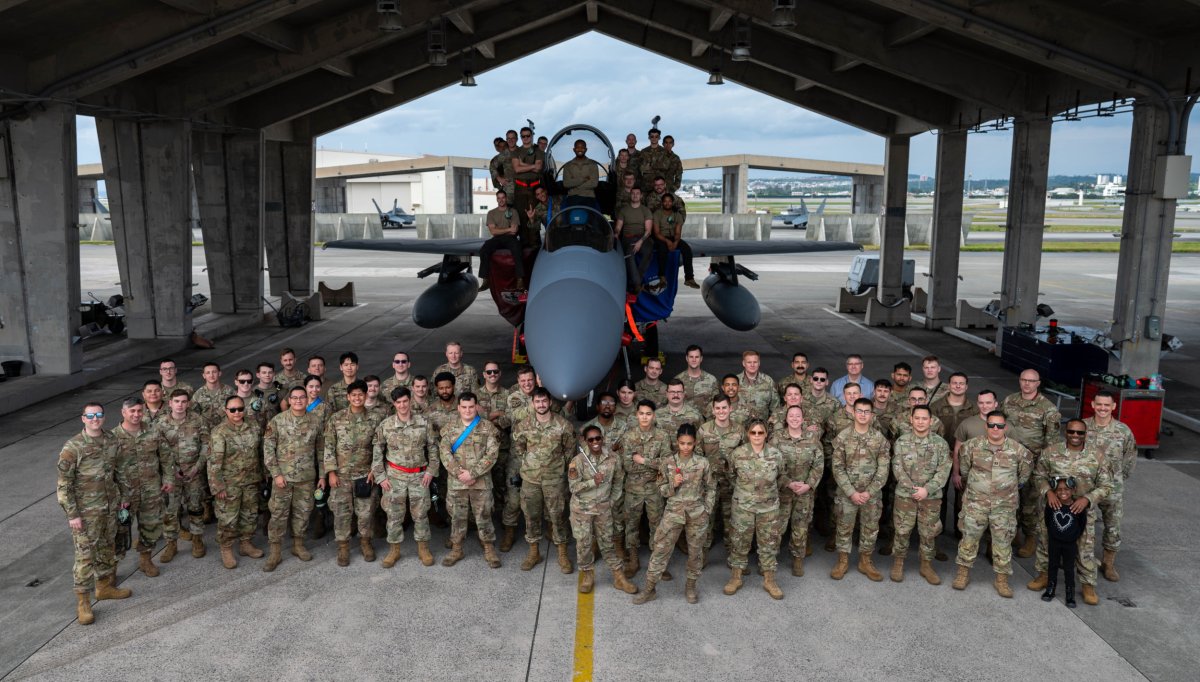The U.S. Air Force has provided Newsweek with an update on fighter jets stationed in Okinawa to counter threats posed by China and North Korea following reports that F-15 aircraft were to be withdrawn.
When asked if all the F-15s at the Kadena Air Base have returned to the U.S., a spokesperson declined to disclose specific information because of operational security.
Newsweek has contacted the Chinese Defense Ministry for comment by email. The North Korean Embassy in Beijing, China, did not immediately respond to a request for comment.
Why It Matters
The F-15s have been stationed at Kadena Air Base in Okinawa, which is the closest American air base to Taiwan. China has long claimed the self-ruled island as part of its territory and has refused to renounce using force against it. The 1979 Taiwan Relations Act requires that the U.S. provide the island with defensive arms while also maintaining its own capability to resist any attempt to resolve differences across the Taiwan Strait by other than peaceful means.
Kadena serves as the hub of U.S. air power within the first island chain formed by Japan, Taiwan and the Philippines, part of the United States' island chain strategy aimed at countering possible Chinese aggression.
The U.S. military has also deployed missile-tracking aircraft to Kadena to collect data on North Korea's missile tests.
What To Know
In December, the U.S. Air Force's 18th Wing published photos, titled "The Last Eagle," showing U.S. service personnel posing with an F-15C Eagle fighter jet, which, according to a caption was "set to depart Kadena as part of a large-scale divestment plan to modernize the base's capabilities."
In a statement to Newsweek on Wednesday, Major Alli Stormer, spokesperson for the 18th Wing, provided an update on the fighter jet fleet stationed at Kadena.
When asked if all 48 Eagle fighter aircraft assigned to Kadena have departed and returned to the U.S. mainland, Stormer responded that "we will not disclose the specific timelines of aircraft movements" because of operational security.

In summer 2024, the Pentagon revealed major air power upgrades in Japan. The plan included the withdrawal of Kadena's F-15C/D fleet that has been stationed there since 1979, replacing them with 36 newer F-15EX Eagle II fighters.
This aims to better deliver "unmatched" combat air power that promotes peace and stability in the Indo-Pacific region, according to the 18th Wing. Kadena will maintain a "rotational presence" of fourth- and fifth-generation fighter jets during this air power transition period.
Stormer said the current rotational fighter jets stationed at Kadena are F-22A Raptors from Joint Base Elmendorf–Richardson in Alaska, F-16C Fighting Falcons from Shaw Air Force Base in South Carolina, and F-35A Lightning IIs from Hill Air Force Base in Utah.
Brigadier General Nicholas Evans, the commander of the 18th Wing, revealed during an interview with Stars and Stripes last month that he expects that Kadena will receive its first F-15EX fighter aircraft "somewhere between the next 12 to 16 months."
What People Are Saying

U.S. Air Force Brigadier General Nicholas Evans told Stars and Stripes: "We're going to fly aircraft and challenge many of these egregious air defense identification zones that China has tried to implement, whether it's in the East China Sea or the South China Sea."
The Pentagon said in an announcement on air power upgrades in Japan: "The Department's plan to station the Joint Force's most advanced tactical aircraft in Japan demonstrates the ironclad U.S. commitment to the defense of Japan and both countries' shared vision of a free and open Indo-Pacific region."
What Happens Next
The U.S. Air Force is likely to continue its rotational presence of fighter jets at Kadena this year as China has unveiled several new military aircraft, including two stealth combat aircraft that rival the American F-22A and F-35A advanced fifth-generation jets.




















 English (US) ·
English (US) ·